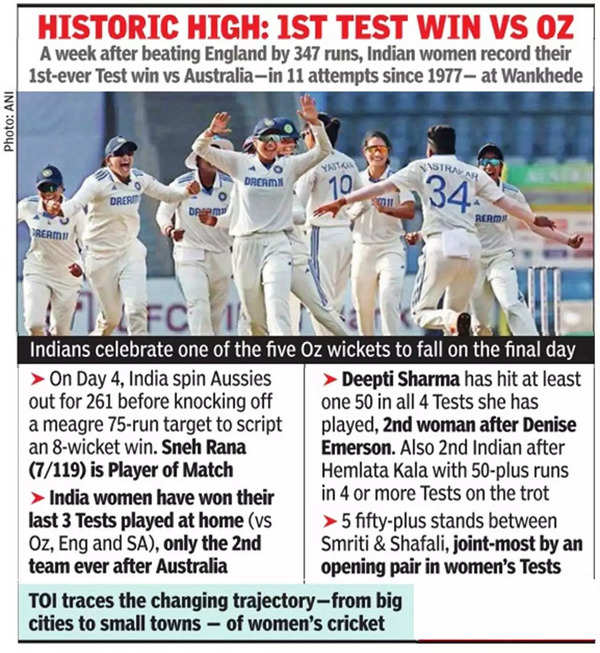[ad_1]
Nearly 47 years later at Mumbai’s Wankhede stadium on Sunday, captain Harmanpreet Kaur‘s rampant India finally rewrote history.This was India’s first win over Australia in Tests. The handsome eight-wicket victory came in the 11th Test after the two sides had battled in places as different as Carrara, a Gold Coast suburb in Queensland, and Lucknow.

India’s rising fortunes reflect the huge change in the women’s team’s geographical base over the past several years. The bulk of Chennai-born Rangaswamy’s team in the 1970s came from cosmopolitan India: opener-keeper Fowzieh Khalili, fellow opener Shobha Pandit, all-rounder Diana Edulji – were from Bombay. Left-arm spinner Sharmila Chakraborty belonged to Calcutta and leg spinner Shubhangi Kulkarni, who took 6/99 in the first innings in that game, was born in Poona.
The places where our new generation of women Test cricketers are born and bred has changed dramatically since then. Captain Kaur comes from small town Moga in Punjab, where as a kid she played alongside boys because girls didn’t play cricket. So did Rohtak’s Shafali Verma. She cut her hair short to pass off as a boy, because some boys didn’t want to play with a girl.
Richa Ghosh, who made her Test debut with a vital 52 and smartly ran-out Beth Mooney, hails from the north Bengal town of Siliguri.
Pooja Vastrakar, whose five wickets and 47 runs were key to India’s victory, grew up in the hilly and forested district of Shahdol in Madhya Pradesh. Together these players underline the wealth of talent that lies in India’s interiors. Mumbai’s Jemimah Rodrigues is an exception.
There’s more. Even batting star Smriti Mandhana comes from Sangli in south Maharashtra. Player of the match Sneh Rana was born in Dehradun, pacer Renuka Singh belongs to Shimla and Deepti Sharma, India’s premium all-rounder, learnt her cricket in Agra underlining the team’s pan-India reach.
Changes are processes, not events. Agra has also produced Test cricketers in the past such as Hemlata Kala and Preeti Dimri. But those running cricket academies in Taj town told this reporter in 2018 how the number of aspiring girl cricketers has grown, how more and more girls, even from smaller towns, are participating in junior trials, and that most aspirants come from middle and lower middle-class homes.
Now with the Women’s Premier League a reality, cricket is likely to be seen as a more important avenue of upward economic and social mobility. Which is good news for women’s cricket.
[ad_2]
Source link

